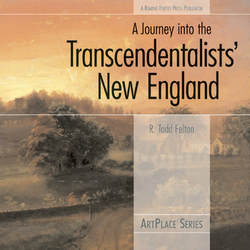Читать книгу A Journey Into the Transcendentalists' New England - R. Todd Felton - Страница 12
На сайте Литреса книга снята с продажи.
Transcendentalism Defined: An Original Relation to the Universe
ОглавлениеIn his efforts to explain how Transcendentalism fit into the “new times,” Emerson identified two types of thinkers, Materialists and Idealists. The Materialists were rationalists, absorbing data from their senses and constructing the truth of the world from what they could hear, see, taste, smell, and touch. Rationalism, exemplified by the theories of British philosopher John Locke, was the bread and butter of the Unitarianism that had begun to dominate the theological landscape in the states that make up New England: Massachusetts, Connecticut, New Hampshire, Maine, Vermont, and Rhode Island.
The Idealists (or Transcendentalists) believed, with Kant and Plato before them, that there are truths that come primarily from intuition rather than sensory experience. In his Critique of Pure Reason, Kant maintained that humans’ understanding of God came from an intuitive recognition of the inherent truth of his existence, not from external proof. This assertion, along with supporting ideas from philosophers such as Viktor Cousin, Madame de Staël, and Jean-Jacques Rousseau, as well as the British Romantic poet Samuel Taylor Coleridge, provided a theoretical basis for the literature, theology, and social activism that would define Transcendentalism.
Although many literary critics view Emerson’s 1836 work Nature as the founding document of Transcendentalism, it is clear that the Reverend William Ellery Channing’s 1828 Unitarian sermon “Likeness to God” is the urtext of the canon. In it, Channing posited that there is a single spiritual entity present in all of us, which we are also all a part of (what Emerson later called the Oversoul). Moreover, Channing said that the best place to study and observe this spiritual unity was in nature.
Although many literary critics view Emerson’s 1836 work Nature as the founding document of Transcendentalism, it is clear that the Reverend William Ellery Channing’s 1828 Unitarian sermon “Likeness to God” is the urtext of the canon. In it, Channing posited that there is a single spiritual entity present in all of us, which we are also all a part of (what Emerson later called the Oversoul). Moreover, Channing said that the best place to study and observe this spiritual unity was in nature.
Mirroring such British Romantic poets as William Wordsworth, many Transcendentalist writers looked to nature for inspiration and signs of a divinity. Because they believed that Nature (now with a capital N) represented all of humankind as well as God, they felt that much could be learned by closely examining the minute elements of nature as microcosms of the larger world. In addition, much Transcendentalist literature encouraged and valued the creative individual who, spurred on by the muse of Nature, used prose and poetry to pose new ideas and new connections. There was also a concurrent turning away from the neoclassical values of order, abstraction, and symmetry toward a more organic, free-flowing art.
The first widely distributed example of this more organic art came in 1836 with Emerson’s thin volume, Nature. This ninety-five-page extended essay provided in its first paragraph a central tenet of Transcendentalism: “The foregoing generations beheld God and nature face to face.... Why should not we also enjoy an original relation to the universe?” Indeed, much of Transcendentalism can be summed up as the individual’s quest for an “original relation to the universe.” This is much of what drove Emerson from the pulpit into his study to become a writer and thinker. It is why Henry David Thoreau went to Walden Pond and why George Ripley founded the Brook Farm utopian community. It is also what inspired the lyricism of Emily Dickinson’s poetry and Nathaniel Hawthorne’s dark glimpses into America’s past.
This quest took place in both individual actions and group meetings, in specific written lines as well as large-scale social reform programs, and in the secular arena as well as the religious. As the Transcendentalist literary critic Elizabeth Palmer Peabody pointed out, the Transcendentalists were hard to pigeonhole: “Transcendentalism belongs to no sect of religion, and no social party. It is the common ground to which all sects may rise, and be purified of their narrowness; for it consists in seeking the spiritual ground of all manifestations.”
